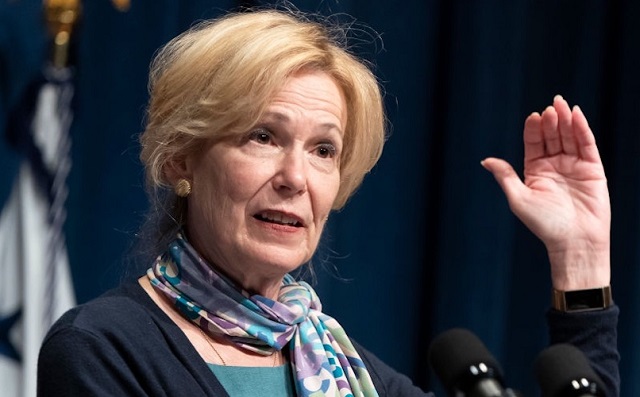Uncategorized
Save Taylor Swift. Stop deep-fake porn: Peter Menzies

Photo by Michael Hicks, via Flickr
From the MacDonald Laurier Institute
By Peter Menzies
Tweak an existing law to ensure AI-generated porn that uses the images of real people is made illegal.
Hey there, Swifties.
Stop worrying about whether your girl can make it back from a tour performance in Tokyo in time to cheer on her boyfriend in Super Bowl LVIII.
Please shift your infatuation away from your treasured superstar’s romantic attachment to Kansas City Chiefs’ dreamy Travis Kelce and his pending battle with the San Francisco 49ers. We all know Taylor Swift’ll be in Vegas for kickoff on Feb. 11. She’ll get there. Billionaires always find a way. And, hey, what modern woman wouldn’t take a 27-hour round trip flight to hang out with a guy ranked #1 on People’s sexiest men in sports list?
But right now, Swifties, Canada needs you to concentrate on something more important than celebrity canoodling. Your attention needs to be on what the nation’s self-styled feminist government should be doing to protect Swift (and all women) from being “deep-faked” into online porn stars.
Because that’s exactly what happened to the multiple Grammy Award-winner last week when someone used artificial intelligence to post deep-fakes (manipulated images of bodies and faces) of her that spread like a coronavirus across the internet. Swift’s face was digitally grafted onto the body of someone engaged in sexual acts/poses in a way that was convincing enough to fool some into believing that it was Swift herself. Before they were contained, the deep-fakes were viewed by millions. The BBC reported that one single “photo” had accumulated 47 million views.
For context, a 2019 study by Deeptrace Labs identified almost 15,000 deep-fakes on streaming and porn sites — twice as many as the previous year — and concluded that 96 per cent were recreations of celebrity women. Fair to assume the fakes have continued to multiply like bunnies in spring time.
In response to the Swift images, the platform formerly known as Twitter — X — temporarily blocked searches for “Taylor Swift” as it battled to eliminate the offending depictions which still found ways to show up elsewhere.
X said it was “actively removing” the deep-fakes while taking “appropriate actions” against those spreading them.
Meta said it has “strict policies that prohibit this kind of behavior” adding that it also takes “several steps to combat the spread of AI deepfakes.”
Google Deepmind launched an initiative last summer to improve detection of AI-generated images but critics say it, too, struggles to keep up.
While the creation of images to humiliate women goes back to the puerile pre-internet writing of “for a good time call” phone numbers on the walls of men’s washrooms, the use of technology to abuse women shows how difficult it is for governments to keep pace with change. The Americans are now pondering bipartisan legislation to stop this, the Brits are boasting that such outrageousness is already covered by their Online Safety Act and Canada so far …. appears to be doing nothing.
Maybe that’s because it thinks that Section 162 of the Criminal Code, which bans the distribution or transmission of intimate images without permission of the person or people involved, has it covered.
To wit, “Everyone who knowingly publishes, distributes, transmits, sells, makes available or advertises an intimate image of a person knowing that the person depicted in the image did not give their consent to that conduct, or being reckless as to whether or not that person gave their consent to that conduct, is guilty of an indictable offence and liable to imprisonment for a term of not more than five years.”
Maybe Crown prosecutors are confident they can talk judges into interpreting that legislation in a fashion that brings deep-fakes into scope. It’s not like eminent justices haven’t previously pondered legislation — or the Charter for that matter— and then “read in” words that they think should be there.
Police in Winnipeg recently launched an investigation in December when AI-generated fake photos were spread. And a Quebec man was convicted recently when he used AI to create child porn — a first.
But anytime technology overrides the law, there’s a risk that the former turns the latter into an ass.
Which means there’s a real easy win here for the Justin Trudeau government which, when it comes to issues involving the internet, has so far behaved like a band of bumbling hillbillies.
The Online Streaming Act, in two versions, was far more contentious than necessary because those crafting it clearly had difficulty grasping the simple fact that the internet is neither broadcasting nor a cable network. And the Online News Act, which betrayed a complete misunderstanding of how the internet, global web giants and digital advertising work, remains in the running for Worst Legislation Ever, having cost the industry it was supposed to assist at least $100 million and helped it double down on its reputation for grubbiness.
Anticipated now in the spring after being first promised in 2019, the Online Harms Act has been rattling around the Department of Heritage consultations since 2019. Successive heritage ministers have failed to craft anything that’ll pass muster with the Charter of Rights and Freedoms so the whole bundle is now with Justice Minister Arif Virani, who replaced David Lametti last summer.
The last thing Canada needs right now is for the PMO to jump on the rescue Taylor Swift bandwagon and use deep-fakes as one more excuse to create, as it originally envisioned, a Digital Safety czar with invasive ready, fire, aim powers to order take downs of anything they find harmful or hurtful. Given its recent legal defeats linked to what appears to be a chronic inability to understand the Constitution, that could only end in yet another humiliation.
So, here’s the easy win. Amend Section 162 of the Criminal Code so that the use of deep-fakes to turn women into online porn stars against their will is clearly in scope. It’ll take just a few words. It’ll involve updating existing legislation that isn’t the slightest bit contentious. Every party will support it. It’ll make you look good. Swifties will love you.
And, best of all, it’ll actually be the right thing to do.
Peter Menzies is a senior fellow with the Macdonald-Laurier Institute, past vice-chair of the CRTC and a former newspaper publisher.
Uncategorized
RCMP recruitment failure has Alberta advocacy group calling for Provincial Police Service

News release from Free Alberta Strategy (A Strong And Sovereign Alberta Within Canada)
“Make no mistake, we are paying for these services that we aren’t receiving. Alberta’s taxpayers are paying tens of millions of dollars for nearly 400 vacant RCMP officer positions – for boots that are not on the ground.”
A recent report from the Royal Canadian Mounted Police (RCMP)’s independent Management Advisory Board had findings that are nothing short of alarming:
“Federal policing has now arrived at a critical juncture of its sustainability, which present risks for the national security and safety of Canada, its people, and its interests,” says the report.
After over a year of diligent study, the Board has been tirelessly firing off flares, signalling to all who will listen: the very foundation of our national public safety apparatus may be at risk of faltering.
This is doubly problematic because, as you well know, the RCMP is also responsible for boots-on-the-ground policing in large parts of the country, including many rural and remote areas – including in Alberta.
Rural crime has been a longstanding issue in Alberta, and social disorder continues to make headlines nightly.
Alberta Minister of Public Safety, Mike Ellis, took to social media platform X (formerly known as Twitter) to express his opinion:
“The independent report finds the RCMP has struggled in recent years to recruit and retain regular members, a problem that’s particularly acute in federal policing. This is not about the hard-working men and women on the frontline: they are doing everything they can. The reality is the RCMP do not have enough officers to police communities in Canada effectively.”
Ellis has been ahead of this story for months now.
In March, Ellis stated that:
“… on average, Alberta has an RCMP officer vacancy rate of 20 per cent. This means that Alberta is only being served by 1,522 of the 1,911 RCMP officers that the federal government has authorized for Alberta.”
“Make no mistake, we are paying for these services that we aren’t receiving. Alberta’s taxpayers are paying tens of millions of dollars for nearly 400 vacant RCMP officer positions – for boots that are not on the ground.”
The consequences of this capacity crisis are far-reaching.
Not only does it jeopardize the safety of Albertans, but it also undermines the credibility of Canada’s federal police force on the international stage.
With limited resources and personnel, the RCMP’s ability to address pressing national and global security concerns is severely compromised.
The Management Advisory Board, created in 2019 by the federal government to provide external advice to the RCMP commissioner, set up a task force in the fall of 2022 to study the federal policing program.
Overall, the report says budget and personnel shortfalls have left the RCMP “operationally limited,” restricting the number of cases it can take on annually.
Here are some more highlights from the report:
“Canada and its people have already begun to see the repercussions of the federal policing program being stretched thin.”
“Federal policing’s overall eroding capacity may have implications for the credibility of Canada’s federal police force and its investigations on the international stage.”
“Ultimately, this may influence Canada’s overall approach and standing in international politics, including its ability to advance global priorities.”
Clearly, we cannot afford to wait any longer.
Municipalities can ease the burden on our national security services by establishing municipal policing.
Several cities in Alberta already have their own police authorities, and the provincial government is providing funding for others interested in exploring this option.
Grande Prairie is already in the process of establishing their own municipal police service.
No word on how many other municipalities have taken the government up on their offer.
Unfortunately, President of Alberta Municipalities Tyler Gandam (also Mayor of Wetaskiwin) is featured prominently on the National Police Federation’s “Keep Alberta RCMP” website.
Interestingly, the Keep Alberta RCMP website doesn’t mention the fact that the advisory board even exists.
It doesn’t mention the report.
The notion that our federal policing infrastructure teeters on the brink of instability while Gandam appears to be asleep at the wheel, is deeply disconcerting.
The safety and security of Albertans must remain our top priority.
We cannot afford to wait any longer.
The time has come for the province to take swift and decisive measures to bolster policing capabilities in Alberta.
It’s time for Alberta to seriously consider the establishment of an Alberta Provincial Police Service.
It has been one of the core tenets of the Free Alberta Strategy.
If you agree, please reach out to your municipality and ask them to take steps to protect your community.
Together, we can keep Alberta safe.
Regards,
The Free Alberta Strategy Team
P.S. We’re hoping you’ll consider contributing to our cause. Your generous donation helps us make a positive impact in our community. No need to worry about any hold-ups or threats here. We’re just passionate about making a difference, and your support goes a long way in helping us achieve our goals.
Uncategorized
Making Alberta a geothermal energy leader

Eavor announces it’s the #1 geothermal energy startup company in the world – January 2024
Alberta is creating Canada’s first geothermal test site to advance drilling innovation, reduce emissions and create jobs.
Geothermal energy uses naturally occurring heat within the earth to heat water and buildings and generate power, with few emissions or environmental impacts. Alberta has vast pockets of heat below ground, making the province Canada’s geothermal leader, but testing and developing new technologies can be a barrier for many companies. Unlike the United States, Japan and other countries, Canada does not currently have an open-access test site to help spur innovation.
Alberta is taking the first steps to create a new Alberta Drilling Accelerator. This groundbreaking facility would be the first of its kind in Canada, establishing Alberta as a global hub for geothermal technology. This will drive new innovations in geothermal and other clean energy projects that can reduce emissions and power communities around the world.
To kick-start the project, the Alberta government is investing $750,000 to conduct a feasibility study led by Calgary-based Eavor Technologies and other stakeholders. The study is the first step in assessing the proposed facility. It will include identifying a site, business planning, research on the governance model, an economic impact analysis and stakeholder engagement that will lay the groundwork for the initial planning stages of the project.
“Alberta has been a global energy leader for more than a century, renowned for our skilled workforce, innovation and one of the largest oil and gas reserves on the planet. The proposed Alberta Drilling Accelerator presents enormous potential to help our province lead the next wave of energy projects here at home and around the world that reduce emissions, create jobs and enhance energy security.”
The Alberta Drilling Accelerator would help companies test out and develop new geothermal drilling techniques or technologies to reduce emissions and drive growth across the clean energy sector. It would be an open-access, technology-agnostic drilling test facility capable of drilling in challenging environments, including deep depths, high temperatures and different rock types.
The accelerator also would help speed up the development of carbon capture, utilization and storage; helium; critical minerals; and other clean technologies and commodities that rely on Alberta’s drilling sector. All of this helps attract investment and bring new technologies to scale in Canada.
“With cumulative geothermal investment poised to reach $1 trillion by 2050, a geothermal arms race is very much underway to commercialize novel drilling techniques that accelerate geothermal development – exhibited by testing facilities in the United States, China and Iceland. As Canada’s first geothermal test bed, the Alberta Drilling Accelerator will help bring geothermal technologies to scale, supporting companies like Eavor. We commend the Government of Alberta for this bold initiative.”
“We are proud to witness Eavor, a CDL-Rockies alumni company, create new opportunities for innovators like themselves to advance the adoption of energy transition technologies like geothermal. The Alberta Drilling Accelerator will further solidify Alberta’s position as a leader in the global sustainable energy landscape.”
If the feasibility study shows the facility is economically and environmentally viable, and if the project is approved by the Alberta government, the facility will start taking shape at the selected site and drilling could start as early as 2025.
“Canada is home to the most advanced drilling technology in the world. Not only do our members support the responsible development of oil and gas, but we are integral in the extraction of new energy resources like geothermal and critical minerals. Our workers are at the epicentre of Canada’s energy transformation. Our people, technology and processes are leading the way towards a more diverse energy future. The Alberta Drilling Accelerator is a government-enabled policy approach to expand Alberta’s drilling capacity and reach its full potential as the world’s most diverse and technologically advanced producer and exporter of sustainable energy and critical minerals.”
“The Alberta Drilling Accelerator is a testament to Alberta’s innovative and entrepreneurial spirit. Leveraging our oil and gas sector expertise, Alberta is poised to become the global leader in developing new geothermal technologies that will play an integral role in reducing emissions while supporting job creation.”
Quick facts
- The Canadian Association of Energy Contractors estimates that one active drilling rig, whether drilling for natural gas or geothermal, creates approximately 220 direct and indirect jobs and
$1 million in tax revenue. - In 2019, Eavor received $2 million in provincial funding through Emissions Reduction Alberta and Alberta Innovates for the world’s first closed-loop geothermal system.
Related information
-

 City of Red Deer1 day ago
City of Red Deer1 day agoCity Council paving the way for more house suites, backyard suites, tiny homes, and duplexes
-

 Opinion2 days ago
Opinion2 days agoCanada’s fertility, marriage rates plummet to record lows: report
-

 Uncategorized22 hours ago
Uncategorized22 hours agoRCMP recruitment failure has Alberta advocacy group calling for Provincial Police Service
-

 Health20 hours ago
Health20 hours agoPrivate Footage Reveals Leading Medical Org’s Efforts To ‘Normalize’ Gender Ideology
-

 COVID-199 hours ago
COVID-199 hours agoJapan’s most senior cancer doctor: COVID shots are ‘essentially murder’
-

 COVID-192 days ago
COVID-192 days agoFormer COVID coordinator Deborah Birx now admits jabs could have injured ‘thousands’
-

 Bruce Dowbiggin2 days ago
Bruce Dowbiggin2 days agoWhy Do The Same Few Always Get The Best Sports Scoops?
-

 Health24 hours ago
Health24 hours agoTHE WPATH TAPES: Behind-The-Scenes Recordings Reveal What Top Gender Doctors Really Think About Sex Change Procedures







